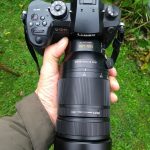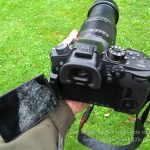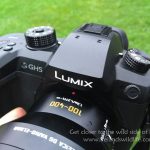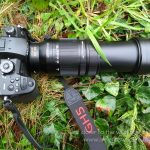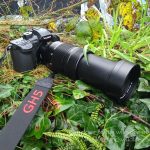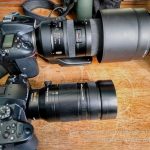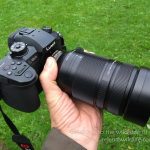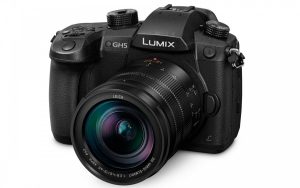 Pros: Professional build quality and comprehensive feature set, incredibly compact and light for an 800mm 35mm equivalent focal length setup, fast accurate autofocus, superb image stabilisation in the body and the lens made hand-holding at long focal lengths possible. Did I mention it was compact and light.
Pros: Professional build quality and comprehensive feature set, incredibly compact and light for an 800mm 35mm equivalent focal length setup, fast accurate autofocus, superb image stabilisation in the body and the lens made hand-holding at long focal lengths possible. Did I mention it was compact and light.
Cons: Autofocus sometimes struggled to isolate small subjects (i.e. birds), focusing on the background instead. So many features (many you’re unlikely to use) make the menu system a bit unwieldy and confusing. LCD viewfinder (LVF) is the best I’ve ever seen, but takes a bit of getting used to if you’re accustomed to an optical viewfinder on a DSLR. Instruction manual a bit sparse.
Price: Panasonic Lumix GH5 Camera (Body Only) GB£1,699.99 (c. €1,920.00); Lumix LEICA DG VARIO ELMAR 100-400mm F4.0-6.3 GB£1,499.99 (c. €1,695.00)
Rating: Highly Recommended
 The Lumix GH5 is a mirrorless system camera that offers the flexibility and performance associated with professional full-size DSLRs and interchangeable lenses, but at a fraction of the bulk and weight. Paired with the Lumix 100-400mm Leica lens it delivers a high performance imaging system with a 35mm equivalent reach of up to 800mm, in a form factor that’s much more compact and lightweight.
The Lumix GH5 is a mirrorless system camera that offers the flexibility and performance associated with professional full-size DSLRs and interchangeable lenses, but at a fraction of the bulk and weight. Paired with the Lumix 100-400mm Leica lens it delivers a high performance imaging system with a 35mm equivalent reach of up to 800mm, in a form factor that’s much more compact and lightweight.
Potentially that’s a dream combination for wildlife enthusiast who are keen wildlife photographers. While it does take some adjustment (mostly around getting used to an electronic / LCD viewfinder) it’s hard not to be seduced by the small form-factor, superb build quality and pro-level performance of the Lumix GH5.
Check out the Lumix GH5 on the Panasonic UK website. You’ll find the Lumix 100-400mm LEICA lens here.
NB: Since we reviewed the Lumix GH5 Panasonic has announced the new Lumix G9 as its flagship stills camera, while the GH5 tops the lineup as a hybrid stills / video body. Building on the speed and responsiveness inherent in the GH5, Panasonic has labelled the G9 as “the ultimate outdoor and wildlife camera”. Will it live up to that billing? We’ll have to wait until we can get our hands on a review sample to find out.
| | |
Real world perspective: keen birder and occasional Ireland’s Wildlife reviewer Colin Barton took the Lumix GH5 and 100-400mm lens with him on his annual autumn migration pilgrimage to Shetland — find out how he got on.
Panasonic Lumix GH5 & 100-400mm LEICA DG Lens: full review
I’ve been intrigued by the evolution of mirrorless camera systems for a while now… and have had a brief look at a few options over recent years. Smaller and lighter than their DSLR equivalents, I always felt they promised a lot for the wildlife enthusiast who wanted to capture and share their wild encounters. But you need a fast, responsive camera coupled with a fast, responsive lens to get high-quality images of wildlife, and until recently mirrorless cameras simply weren’t up to the task.
However, it seems manufacturers have been working hard to bridge that performance gap.
Enter the Micro Four-Thirds (MFT) format Panasonic Lumix GH5 and the Lumix LEICA DG VARIO ELMAR 100-400mm F4.0-6.3 super-telephoto zoom lens (offering an impressive 200-800mm 35mm equivalent reach).
We’ll be reviewing the lens and camera as a combined setup for all-around wildlife and bird photography here… although the GH5 is packed with features and is compatible with a suite of micro-four-thirds lenses from Panasonic, Olympus, Leica and other third-party manufacturers like Tamron, making it a great all-around system camera for all kinds of photography and 4K video capture.
I won’t delve too much into all the technical bells and whistles of the camera in this review — rather I’ll concentrate on what it’s like to use out in the field for wildlife photography. You’ll find a comprehensive review of the Lumix GH5 on the Digital Photography Review website.
First impressions
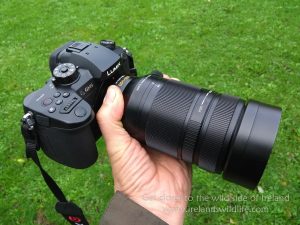 Both the Lumix GH5 and the 100-400mm Leica lens have a solid, professional feel. The camera body is crafted around a strong, lightweight magnesium-alloy chassis, and the overall feel of the body and lens combination is of a robust piece of kit that will stand up to the rigours of life in the field. The camera and the lens are weather sealed — which is also reassuring for expensive gear you’re likely to have out in inclement weather.
Both the Lumix GH5 and the 100-400mm Leica lens have a solid, professional feel. The camera body is crafted around a strong, lightweight magnesium-alloy chassis, and the overall feel of the body and lens combination is of a robust piece of kit that will stand up to the rigours of life in the field. The camera and the lens are weather sealed — which is also reassuring for expensive gear you’re likely to have out in inclement weather.
The other thing that leaps out of you is just how compact and lightweight this camera and lens combination is. For a setup that offers a 35mm equivalent focal length range of 200-800mm it is astonishingly small and while you wouldn’t exactly describe it as light, compared to a full-frame sensor equivalent it’s a veritable featherweight.
Menus and controls
The GH5 is replete with options and has settings for everything you can think of, and probably several others besides.
By and large the menu system is well laid out, and fairly intuitive. Some options (image quality, for example) use icons rather than text and it’s not always obvious what these are — so you have to refer to the manual (the one with the camera is very basic — there’s a more comprehensive one available to download as a PDF file for free), which isn’t always that clear.
Settings are grouped by photography, a group of settings for video, a group of settings for user-defined functions and more. You can also customise the menus to suit your way of working and can assign different functions to the buttons and dials on the camera body — of which there are plenty.
The buttons and dials, as you might expect, give you quick access to the features you’re likely to change on the fly while shooting. Out of the box, these are set to a fairly generic set of default functions that will work well in most situations for most photographers. Of course, you can dive into the menus to customise pretty much all of the camera controls and buttons to behave in exactly the way you want them to.
LCD and Electronic Viewfinder
 The LCD on the back of the Lumix GH5 flips around for protection when not in use… which is a great feature — particularly when you’re mainly using the viewfinder to frame your photographs.
The LCD on the back of the Lumix GH5 flips around for protection when not in use… which is a great feature — particularly when you’re mainly using the viewfinder to frame your photographs.
When needed it simply flips out rotates and clips back into place on the back of the camera. It’s also fully articulated and you can use it at any angle — offering some interesting creative possibilities that would be difficult, if not impossible to achieve with a fixed LCD panel or viewfinder.
The LCD features a 1.62 million dot display that renders both image review and a live-views of the scene beautifully.
For the most part when shooting wildlife you’ll be using the electronic viewfinder (EVF) — which is easily the best I’ve seen on any camera I’ve used to date (NB. I haven’t yet had the opportunity to try the Lumix’s most up-to-date mirrorless competition from manufacturers like Olympus, Sony or Fuji). The viewfinder features a high-resolution OLED display that renders a vibrant, true-to-life image of the scene at a staggering 3,680,000-dot resolution. And the experience is silky smooth, with none of the jumpy lag I’ve always associated with EVFs I’ve used in the past (a nightmare if your subject moves). It also doesn’t black out when shooting continuously — a boon when you’re tracking fast moving wildlife — although using continuous autofocus/focus tracking modes at the camera’s fastest frame rates I did see a very noticeable drop in resolution of the live view, making it tricky to tell whether the focus point was tracking the subject accurately between frames.
Overall the EVF on the Lumix is excellent — but it is still an EVF, which takes a bit of adjustment if you’re moving from the optical viewfinder of a traditional DSLR. On the plus side though, with an EVF what you see in the viewfinder is a direct representation of what the sensor is “seeing” — so essentially what’s in the photograph is what you’re actually photographing, rather than an optical facsimile of what the sensor will record — which means you can see things like over or underexposure, and monitor the effects of applying exposure compensation and other changes in real time… which is nice.
There are all sorts of technical gizmos and overlays you can enable in the EVF to make life “easier”. There’s a horizontal level to keep your horizons straight, edge highlighting for focus, highlighting of overexposed areas, composure aid grids, live histogram data and much, much more. I found much of it redundant and distracting, and ended up turning most of these features off. With everything enabled the EVF changed from a beautifully rendered representation of the scene before me to a multi-hued mish-mash of colour, pattern and data that hindered rather than helped with photography.
Still, I can see shooting situations where each could be useful, so having more features available is good: it means you can configure and customise your viewfinder to best suit your own photographic needs.
Using the camera
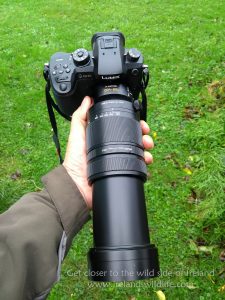
The Lumix GH5 is fast!
Everything about it is high-performance… from its autofocus to its continuous shooting speed to its maximum shutter speed. It’s up there with the best of the best when it comes to speed and responsiveness. For wildlife — when subjects are often moving, and you’re trying to capture that elusive instant, that’s crucial.
When photographing wildlife, I predominantly use either shutter priority auto or aperture priority auto. Those were the only modes I used throughout the review period. Of course, the GH5 offers a full complement of additional modes, from fully manual through full auto to “idiot proof” scene modes that attempt to optimise camera settings to suit different shooting scenarios.
The large mode dial on top of the camera body has a locking mechanism to prevent your chosen setting being inadvertently changed in your bag or when you’re carrying the camera over your shoulder.
In the hand
The GH5 with the 100-400mm Leica lens fitted is not a small camera. You couldn’t really describe it as a light camera either… not in the way a “point and shoot” would be. But this is no point-and-shoot — this is pro-spec gear that can, in the right hands, deliver professional quality results.
Compared to an equivalent DSLR setup, even one at the lightweight end of the spectrum, this is a veritable featherweight. It’s an absolute joy to carry and use in the field.
In fact, it’s a setup that you’d be inclined to carry with you more often because of its portibility — which means you may well get shots you’d otherwise have missed due to leaving your “good camera” at home.
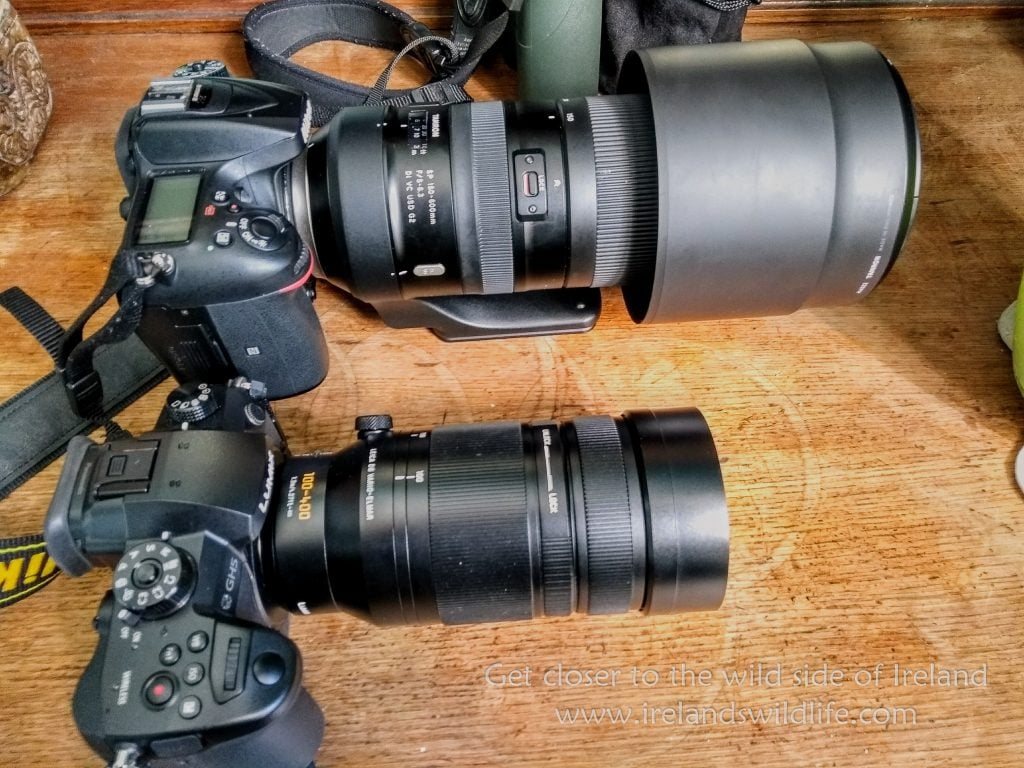
Speed and responsiveness
After the build quality, and how compact and portable it is, the next thing you notice about the Lumix combination is how fast it is. For wildlife, speed in almost every facet of a camera’s performance matters… and the Lumix GH5 is a quick camera. From super-fast autofocus to impressive focus tracking capabilities, high maximum shutter speeds and rapid continuous shooting rates this is a camera that can keep up, whatever the subject.
Autofocus
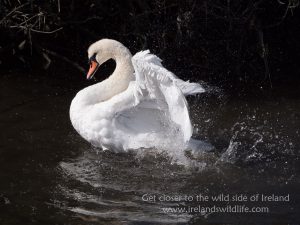
I was very pleasantly surprised the first time I pointed the Lumix GH5 / 100-400mm combo at a static target and pushed the back button to focus (I’ve been using back button focus for some time, and find it invaluable… hat tip to Mike Brown for the suggestion — setting it up on the GH5 was really easy). The subject in the viewfinder snapped into focus almost instantly. It’s not that I was expecting the camera to be slow… I’d read the specs before receiving it, so knew it was going to be fast. I just wasn’t prepared for just how fast.
Time to try something a bit more challenging.
I didn’t have to look far. There were blue tits, great tits and coal tits jostling for position with a resident flock of house sparrows the occasional goldfinch and a family of greenfinches at the feeding station. Moving from bird to bird, switching focus, and following/tracking individual birds was all quick, fluid and instinctive. So far, so good.
In fact, the autofocus performed exceptionally well throughout the review period, as long as the subject was comparatively large in the frame. When it did struggle was picking out a small bird (small even at the full 800mm equivalent full focal length) against a fairly uniform background. The camera generally wanted to focus on the background, and it was hard to get it to notice and lock on to the intended subject.

That’s not so important in “proper” photography because in such cases the subject is too distant/small to render an acceptable photographic image anyway. However, quite often as wildlife enthusiasts and birders we simply want to capture a record (the eponymous record shot) of a species… either to assist with ID later, or, in the case of rare migrants, to prove that we’ve actually seen what we say we’ve seen (yes, it does happen).
You can get around it… either by “tweaking” focus using the manual focus override ring (once you acquire focus the Lumix seems to have no problem maintaining it) or by reframing, focusing on something a similar distance away to your subject, then reframing again. Neither of these options is ideal… especially when the subject in question is a small bird that can take flight at any moment.
Overall though the camera’s autofocus performed well, and the lens motor was fast, quiet and smooth. The lens has a handy selector switch that lets you limit focus range — so if you know you’re only going to be photographing subjects from 5m out to ∞ then you can flip to prevent the lens dropping below 5m when trying to lock focus, resulting in even faster autofocus performance. In practice, I never used this feature. I was always afraid something interesting might pop up closer to the camera and I’d miss the shot. To be honest the autofocus always seemed plenty fast enough without limiting the focusing range.
The GH5 lets you choose between three autofocus modes… AFS (Auto Focus Single — the camera will focus on the subject and lock focus, allowing you to adjust composition before taking the shot), AFF (Auto Focus Flexible — the camera will focus on the subject as in AFS, but if the subject then moves the camera will attempt to maintain focus on the subject) and AFC (Auto Focus Continuous — the camera will attempt to maintain focus continuously tracking the subject as it moves).
For wildlife typically AFC is the best option.
There are 225 autofocus points spanning almost the entire field of view of the GH5, and you can switch between them using a handy joystick beside the viewfinder or using the LCD touchscreen.
Focus tracking
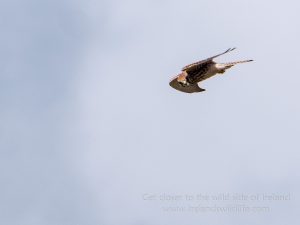
One of the biggest problems I had with moving subjects, initially at least, was finding them in the viewfinder and locking the focus. That wasn’t so much an issue with the camera and lens… more a general issue with long-lens photography in general. at long focal lengths the narrow field of view coupled with the magnified “camera shake” makes pinning down a moving subject tricky.
The dual in-camera and in-lens image stabilisation really help here (more on that in a moment) but it still takes a bit of adjustment to the new camera and lens combination before you’re nailing focus on things like birds in flight.
When you do get your subject framed the camera locks on to it almost instantly, and focus tracking of birds in the frame worked very well — as long as I could keep them in the frame (bouncing, wheeling, diving choughs are practically impossible to track — a shortcoming of this photographer, not the camera).

Larger slower moving subjects — like the red deer stags in Killarney National Park during the annual rut, were much easier to find, focus and track in the viewfinder. Carrying the GH5 and 100-400 around was never a chore, and you always felt you were ready for anything.
The GH5 also lets you fine tune autofocus parameters depending on the subject your shooting, letting you choose from selected presets for AF Sensitivity (when the camera should / shouldn’t jump focus to something crossing between the camera and the original subject), AF Area Switching (the degree to which the camera should follow a subject around the frame) and Moving Object Prediction (letting the camera know how consistent and predictable the subject’s movement across the frame will be).
Continuous shooting
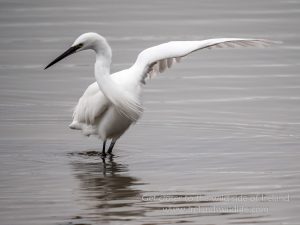
Using the mechanical shutter the GH5 is capable of an impressive 12 frames per second in AFS mode (focus fixed on the first frame) or 9 frames per second in AFC (continuous focus tracking). That’s pretty damned quick… but for those times when you absolutely need to nail the shot, the GH5 has a trick up its sleeve. Its 6KPhoto mode allows you to shoot at an effective 30FPS (shooting ultra HD video and extracting individual frames as 18MP still images) and its 4KPhoto mode allows you to bump the frame rate to a staggering 60FPS to capture images up to 8MP.
Generally, 9FPS in AFC mode is going to be enough… but it’s good to have additional options for those times when capturing the pivotal moment of high-octane action is critical.
Image Stabilisation
Another area where the cutting edge technology packed into the Lumix system really shines is with it’s in-body and in-lens image stabilisation. Traditional DSLRs only incorporate image stabilisation in the lens, and while some of these perform extremely well — particularly on higher-end lenses — Panasonic has taken image stabilisation a step further with the Lumix line.
The Dual IS2 system combines 5-axis sensor-shift image stabilisation in the camera body with optical image stabilisation built into longer Lumix lenses to give an impressive 5-stop equivalent of stabilisation. That means with stationary subjects you can get sharp images at much slower shutter speeds — and makes hand-held shooting at lower light levels and with longer lenses a viable option, obviously a boon for wildlife photographers.
Obviously being able to shoot at slower shutter speeds isn’t going to help much when your subject is on the move — but there’s another benefit. The image stabilisation system also helps stabilise the live view through the viewfinder… which makes finding, tracking and framing your subject MUCH easier, particularly at the longer end of the focal length range you tend to need when photographing wildlife.
Battery Life
With its LCD viewfinder, the GH5 was always going to be more power hungry than a DSLR with a mirror and optical viewfinder. The included battery will get most people through a typical day’s shooting (it’s good for around 400 shots), but you will find you need to charge it frequently, and possibly after every shoot to make sure you don’t run out of juice at a crucial moment.
In fact I’d recommend buying a spare battery or two to keep in your camera bag, or investing in the optional pro battery grip if you’re planning on doing any intensive shooting with the camera.
Image quality
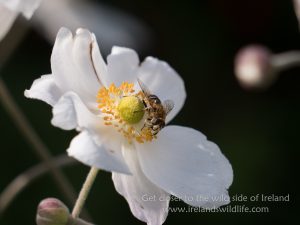
I have to say I was very impressed with the image quality from the GH5 and the Leica 100-400mm. The lens is pin sharp and appears to maintain that sharpness throughout the zoom range. While it may be a tad sharper in the mid-range apertures (f8-f11), as this isn’t a particularly fast (aperture-wise) lens, most of the time I was shooting wide open (f5.6-6.3) and saw little if any drop off in image sharpness.
The smaller micro-four-thirds sensor is always going to be noisier at higher ISO levels than an equivalent larger sensor on bigger / bulkier system cameras… but the 20mp sensor in the GH5 and the image processing engine in the camera does an excellent job of controlling that noise to acceptable levels up to around ISO 3200 — above that you start to get quite noticeable noise… but I was very happy with the handheld images I managed to get at 400mm f6.3 (800mm 35mm equivalent) photographing red deer in low light in Killarney at ISO 3200. Yes there’s some noise / grain in the image… but if anything I think it adds to the atmosphere.
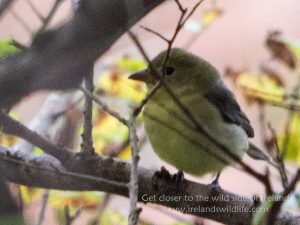
Higher ISO levels also work fine for those oh-so-crucial record shots… where photographic perfection is less important than getting a reasonably exposed, identifiable record of the subject.
Overall the image quality of the Lumix GH5 is very good to excellent. Yes, you’ll likely get higher quality images if you start “pixel peeping” images from higher resolution full-frame sensors from much bulkier and more expensive cameras — but considering the tradeoffs in size and bulk, and the practicalities of carrying your gear in the field, the Panasonic Lumix GH5 and Leica 100-400mm does a fantastic job.
Ports and Connectivity
As you might expect from a flagship camera packed with the latest technology, Panasonic hasn’t shirked on the connectivity options with the GH5. You’ll find a full-size HDMI port, a USB-c port supporting the 5Gbit/sec USB 3.1 standard, microphone and headphone ports and a pair of SD Card slots supporting SD/SDHC/SDXC (UHS-II compatible).
Wireless connectivity options include integrated bluetooth and WiFi, allowing camera control via and export of images to a smartphone or tablet.
A word about video
The Panasonic GH5 is widely lauded for its video capabilities, and perhaps I am the only reviewer not to fully test its stunning 4K Video. In fact, I didn’t shoot video with it at all during the review period, focusing instead on its ability as a stills photography camera.
For those of you interested in video, the Lumix GH5 was designed from the beginning to be a professional grade hybrid stills and video camera. It is capable of recording professional quality 10-bit 4K cinematic quality video at 60p. The GH5 has quickly carved itself a niche as the go-to hybrid camera for video enthusiasts and professionals alike — so if video is an important consideration for you, you should certainly consider the Lumix GH5.
Conclusion
Overall I was very impressed by the overall package of the Panasonic Lumix GH5 and the Leica 100-400mm super-telephoto zoom for wildlife and bird photography. It’s one of the most enjoyable combinations I’ve ever used for photographing wildlife, and the smaller, lighter form factor made it a real joy to carry and use in the field. That meant I was more likely to have the camera with me when out watching wildlife — and consequently meant I could get shots I would normally have missed.
The image quality trade-offs of the smaller micro-four-thirds sensor could be a deal-breaker for professional wildlife photographers… but enthusiasts looking to capture outstanding images of the wildlife and birds they encounter the Lumix GH5 and 100-400mm is a serious contender.
It is the first mirrorless camera I’ve tried that ticks enough boxes to make me seriously consider ditching my Nikon DSLR and moving to a smaller, more portable system.
That said… the new Lumix G9 has since been announced. While the GH5 is positioned as a photo/video hybrid that arguably puts the emphasis on video, the G9 looks to be a very much photography-first camera (that also happens to do good video).
With the same sensor and many of the same features as the GH5, but faster and optimised for high-speed sports and wildlife photographers, the new G9 may be a better option of stills are more your thing. I for one cant’ wait to try it out.
| | |
Technical Specifications
The full spec of the camera is lengthy, so rather than list it here I’ll just link through to the Panasonic site for convenience. You’ll find it here.
Image gallery
Acknowledgement
I’d like to thank Panasonic UK/Ireland for sending the Lumix GH5 and Leica DG Vario-Elmar 100-400mm in for review on Ireland’s Wildlife.
NB. Ireland’s Wildlife has no specific affiliation with any optics or gear manufacturer for review purposes. All reviews on the site are completely independent and objective and carried out in accordance with our terms and conditions. If you’re an optics or gear manufacturer and would like to submit your product for review on the site please drop us a line using the contact form and we can take things from there.












